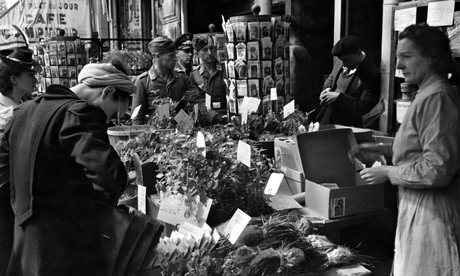
There was a tremendous row in Paris a few years ago when the city's historical library put on an exhibition of photographs entitled Parisians Under the Occupation. The images, mostly in colour, showed elegantly dressed citizens promenading in the streets, shopping, and watching the Longchamps races – and thus contradicted the received idea of the "hard years" as a time of strain and deprivation.
Critics pointed out that André Zucca, who took the pictures, worked for the Germans – and thus had access to Agfa colour film stock. Eventually the show's title was changed from Les Parisiens sous l'occupation to Des Parisiens..., that is, some Parisians, not all of them.
As this episode showed, the process of coming to terms with the French past is still current; indeed, over the past decade every aspect of the Vichy period has been put back into the historian's spotlight.
The part of the story that appeals most to Anglo-Saxon readers – how many people in the French cultural elite were seduced by the power and aura of the Nazis – has already been well told by Alan Riding and Frederic Spotts, while Charles Glass has examined the American side of the occupation. So Ronald C Rosbottom has been forced to cast his net far beyond the usual suspects, and to draw on a huge range of memoirs, novels and interviews. His book's main strength is the sense it gives of how ordinary Parisians coped, but it is also excellent on youth culture, the divisions that marked the Jewish community's response to persecution, the toxic aftermath of liberation, and the mythologies that quickly arose around the war years.
Most of Rosbottom's insights are not his own, however. The notion that the German male conqueror had an irresistible allure for French women comes from Irène Némirovsky. Similarly, the way in which women accused of collaboration horizontale were stripped naked, shorn and paraded through the streets after the liberation is now generally seen as a sad manifestation of the need of French men to reclaim the honour and virility lost on the battlefield in 1940, by degrading the bodies of women.
Rosbottom, who teaches French at Amherst College, Massachusetts, tells us that he does not claim the mantle of the historian, but rather that of a storyteller and guide. He certainly shirks the historian's responsibility to give a real sense of the social, economic and cultural context within which events occurred. His accounts of the role played by the Communist party and of the forced conscription of young men to work in Germany – which proved to be the main recruiting tool for the resistance – are so sketchy that it is impossible for the reader to grasp the full meaning of several episodes featured in the book.
Nothing is said about the institutions of civil life, such as churches, trade unions, freemasons' lodges, veterans' organisations, or even cafes, through which many Parisians defined their identity. Nor is there anything about food, drink or crime.
Instead, the professor devotes much space to notions such as "spatial anxiety" and "our engagement with the urban landscape" and presents cultural-studies cliches with great solemnity. Thus we are told that concierges of apartment buildings enjoyed great power over their residents – a point obvious from a hundred French films and much more tellingly made in Fallada's Alone in Berlin. He also "brings a mixture of interpretative strategies to bear" – that is, plays fast and loose with his sources, sometimes using modern novels set in the 1940s as historical evidence. There will doubtless be many more books to come on this subject. My advice is: wait for a better one.

